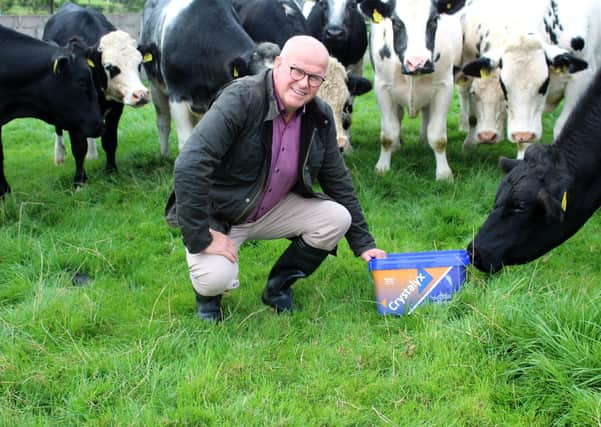Oceans of grass – but how to make best use of it?


But irrespective of how good grass growth rates are at the present time, it must be remembered that autumn grass is deficient in a number of key mineral, vitamins and other important nutrients.
“Fresh grass is never a totally balanced feed for cattle, at any time of the grazing season,” stressed David Morgan, from Caltech/Crystalyx.
Advertisement
Advertisement
“This is particularly so at this time of the year, when mineral and energy imbalances can serve to reduce the nutritional impact of the grass being grazed.
He continued: “One very effective way around this problem is to put Crystalyx Cattle Booster feed blocks out with stock. They have been specifically formulated to nutritionally complement the grass available to cattle of all ages.
“The end result is a significant increase in daily growth rates and overall improvement in animal performance.”
Where suckler cows are concerned, research carried out in both Ireland and the UK has shown that optimising cow nutrition leads to an increased number and weight of calves weaned; a reduced calving period; a reduced time between calving and conception plus fewer empty cows.
Advertisement
Advertisement
Additional trials have shown that Cattle Booster will help to boost rumen development in weanlings at grass.
While grazed grass is by far the cheapest forage to offer suckler cows, it is by no means a complete feed for these animals.
Mineral and vitamin imbalances are an issue as is the fact that, invariably, ruminant livestock need an extra energy source to allow the microbial populations in the rumen make full use of the fresh grass that is available to them.
David Morgan again: “Supplementing grass with Cattle Booster feed buckets can significantly and economically improve suckler cow and weanling performance.
Advertisement
Advertisement
“Independent trial work carried out at Newcastle University has shown that Cattle Booster increases the rate of forage digestion by rumen bacteria by up to 10 per cent. This stimulates grass intakes due to a reduced gut fill effect, thereby increasing forage intake; rather than replacing it.”
David pointed out that Cattle Booster also increases forage digestibility, or D-value, so animals actually get more energy out of what they eat.
He further explained:“These benefits continue throughout the grazing season, as long as forage supplies remain plentiful. For example, it hs been shown that Cattle Booster will act to improve autumn grass D-values by an average of 6.8%. Or put another way, increasing D-value by 6 units effectively increases forage energy content by 1MJ/kg dry matter.
“Cattle Booster provides all the minerals, trace elements and vitamins needed to balance grass, which are essential for optimum animal performance and health.
Advertisement
Advertisement
“Rumen bugs also need minerals to help them digest the grass and the little and often trickle feeding system supplied by Cattle Booster is an ideal method of ensuring this.”
According to David, Cattle Booster constitutes a concentrated source of sugar. This is important to help maintain rumen digestive efficiency.
He commented:“Cattle Booster will also provide suckler cows and calves with that all-important nutritional lift, thereby ensuring optimal milk yields and daily liveweight gains.
“The product has been formulated to balance typical mineral and vitamin deficiencies seen in pasture. It offers a comprehensive mineral and vitamin package in the form of a weatherproof, free access, molasses feed lick.
Advertisement
Advertisement
“Feeding supplementary meal is not practical options for significant numbers of livestock farmers, once cows and young stock go out to grass.
“The good news is that Cattle Booster feed blocks are a proven management option, when it comes to meeting the complete nutritional needs of cattle.”